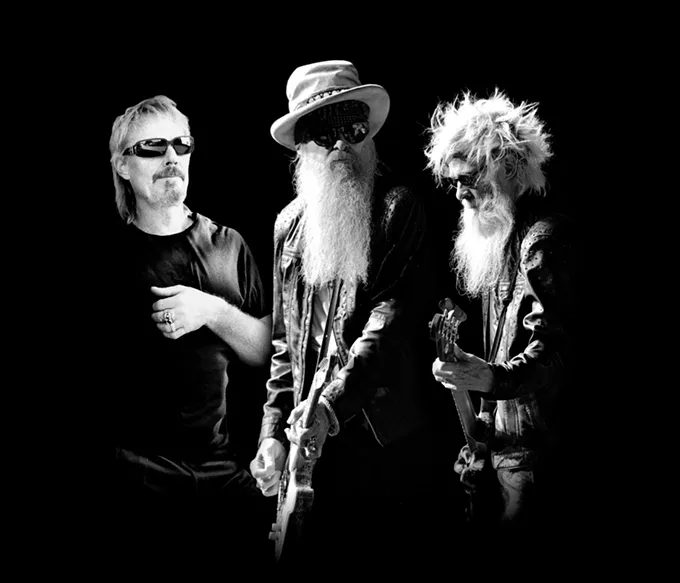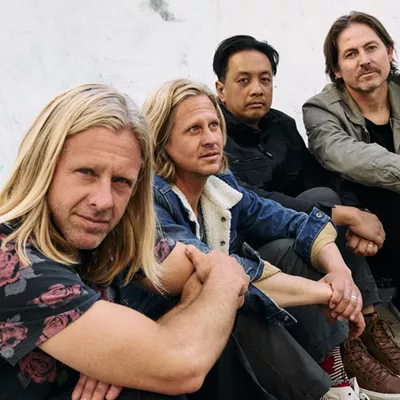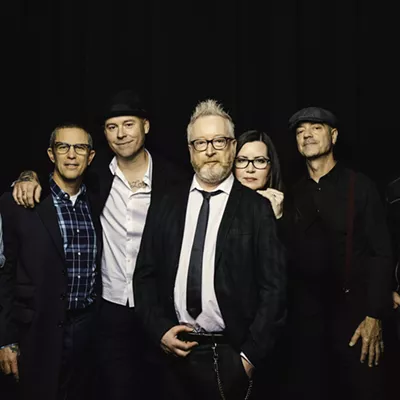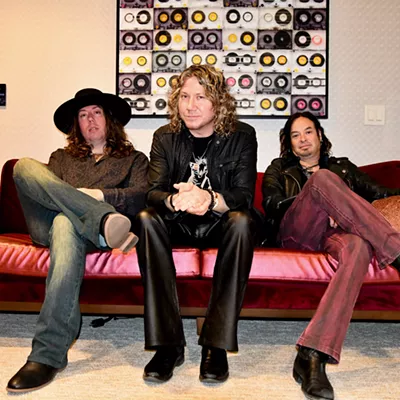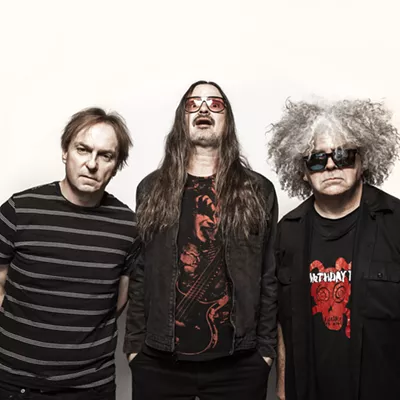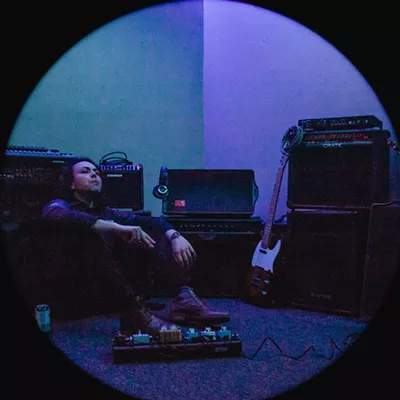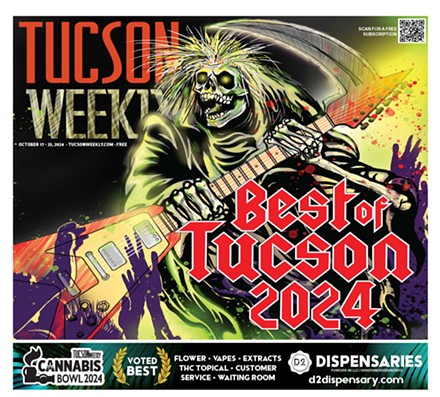ZZ Top’s “Raw” is as close to being an accidental album as it gets.
The album, which was released in July 2022, is drawn from a session at Gruene Hall in New Braunfels, Texas, in which singer/guitarist Billy Gibbons, bassist Dusty Hill and drummer Frank Beard set up and played versions of such familiar songs as “La Grange,” “Tush,” “I’m Bad, I’m Nationwide,” “Gimme All Your Lovin’” and “Legs” in the most live, spontaneous and basic setting possible.
The performances were filmed for use in the recent ZZ Top documentary “That Little Ol’ Band from Texas,” which celebrated the band’s 50-year history with its original lineup. When the trio unplugged and left Gruene Hall that day, they thought it was mission accomplished. The footage was shot and recorded, and it is the end of the story.
“The tunes on that occasion unfolded quite in the moment,” Gibbons said, recalling the session in an email interview. “Our director, Sam (Dunn), wanted a sequence where we played in the present day as a balance to the film’s historical narrative. We got in there and did what we did and later, much later, realized we had an album.”
As Gibbons indicated, upon further review, the performances captured something worth hearing in its entirety — the unmistakable Texas blues-rock boogie of ZZ Top in its most authentic state. And the “Raw” album became a reality.
The album figures to take on some significance as one of the last live documents of ZZ Top with Hill, who died in July 2021. Long-time guitar tech Elwood Francis had stepped in on bass on occasions when Hill had injuries or health issues that prevented him from touring. When Hill died, the band barely took time off before resuming the tour, knowing that’s what Hill would have wanted.
Nevertheless, Hill’s death came as a shock.
“It was quite sudden, and we remained under the assumption he’d rally, recover and rejoin us,” Gibbons said. “There was no anticipation, mental or otherwise. We just had to deal with the reality of departure and the quick turnaround helped reinforce “the show must go on” ethos. Our crew, our friends, fans and followers have been a huge source of comfort.”
Now ZZ Top, with Francis considered a long-term third member, are back on tour, doing a summer co-headlining run with Lynyrd Skynyrd, playing a show that touches on all 50-plus years of the band’s history.
“We know we’ll go as far back as possible… perhaps ‘Brown Sugar’ or ‘Just Got Back from Baby’s’ from the cleverly titled ‘ZZ Top’s First Album’ or even Willie Brown’s ‘Future Blues’ that predates us by 40-plus years,” Gibbons said. “Of course, (we’ll include) a few of the ones well known like ‘La Grange’ and ‘Legs.’ What’s certain is the famed adage of ‘something old, something borrowed and most definitely something blue’ (will apply).”
ZZ Top’s longevity is notable enough, but the fact that the classic lineup remained intact for 50-plus years makes ZZ Top a rare example of stability and sustained creativity and quality in what is often a volatile reality of being a rock band.
The sound and personal chemistry is something Gibbons, Hill and Beard experienced literally from the first notes they played together.
“Funny thing, our first, I’ll call it a jam session together, Dusty was in line to pick up the bass guitar and throw his hat into the ring. And what was going to start up as a three-minute shuffle in C turned out to be a three-hour jam session,” Gibbons recalled. “We knew something was cooking.”
That initial jam session is recalled quite colorfully in “That Little Ol’ Band from Texas,” during which Gibbons, Hill and Beard take viewers along for a trip through ZZ Top’s 50-year history. The film hits a lot of highlights, including how Gibbons, who had come up on the vibrant Houston music scene and had a measure of success in the band Moving Sidewalks, came to know Beard, who then connected him with Hill (both from Dallas) to form ZZ Top, how the group got its distinctive high-powered sound and their initial commercial breakthrough. From there, the film visits a late ‘70s period that included a hiatus and Beard’s battle with addictions and moves onto the 1980s, when ZZ Top incorporated synthesizers and sequencers into their sound and hit a commercial grand slam with the 1983 album, “Eliminator,” before reaching into the present day.
In ZZ Top’s early years, the band gained a lot of mystique, in part because its manager, Bill Ham, limited the band’s number of interviews and television appearances.
Some didn’t quite know what to make of the band’s blues-rooted, Texas-infused style of rock, either. That’s a key reason the band decided to bring a bit of the Lone Star State to the rest of the country in the mid-1970s on the “Worldwide Texas” tour. The famous outing had the band joined on stage by live animals, including a buffalo, a steer and a buzzard, the latter of which hung out near Beard’s drum set.
“The only time it got sticky was when the buffalo made his escape,” Gibbons recalled. “One afternoon we were, actually we played Three Rivers Stadium (in Pittsburgh), and I’ll never forget seeing the trainer in a golf cart trying to catch up to the buffalo stampeding and zig zagging across third base to home plate.”
ZZ Top stayed popular into the early 1980s, when a convergence of factors – the arrival of sequencers and other recording tools, the debut of MTV (which aired the groundbreaking videos for the hit songs “Legs,” “Gimme All Your Lovin’” and “Sharp Dressed Man”) and some inspired songwriting — made ZZ Top mega-platinum superstars (with Gibbons and Hill debuting their newly grown outsized beards).
The makeover in the ZZ Top sound wasn’t planned. Upon arriving at Ardent Studios in Memphis to record “Eliminator,” the trio for the first time encountered sequencers and synthesizers and soon figured out how to use them to modernize their bluesy sound.
“We stumbled into the control room, and here were these new contraptions,” Gibbons said. “We had a habit of ignoring the user’s manual. We just started twisting knobs and somehow that’s what worked.”
Indeed, after reaching their commercial peak with “Eliminator,” the sonically similar “Afterburner” (1985) and “Recycler” (1990), ZZ Top have returned to more of a stripped-back bluesy guitar sound on their most recent albums — “La Futura” (2012), “Mescalero” (2003) and “XXX” (1999). Sales of those albums have fallen off, but ZZ Top remains a touring powerhouse.
And Francis is making his presence felt in the live shows.
“Elwood’s instrumental presentation is solid. The Elwood sound has it down,” Gibbons said. “Vocally, of course, it’s surprisingly different. Elwood is great with harmonies and backup stuff, so we’ll just leave it at that.”
And with Francis aboard, Gibbons considers ZZ Top a band with plenty to say musically. Speaking of which, before Hill died, the trio had been in the studio working on some songs Gibbons had brought in from sessions for his 2021 solo album, “Hardware,” as well as other material with the thought it might develop into a ZZ Top album of new material.
“Elwood is certainly in with us for the long haul,” Gibbons said. “It’s still ZZ Top, not ZZ Top 2 or ZZ Top with an asterisk. The genuine article abides.”
ZZ Top
WHEN: 7:30 p.m. Friday, Oct. 25
WHERE: Linda Ronstadt Music Hall, 260 S. Church Avenue, Tucson
COST: Tickets start at $55
INFO: ticketmaster.com

